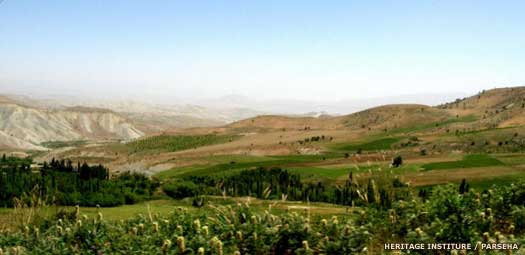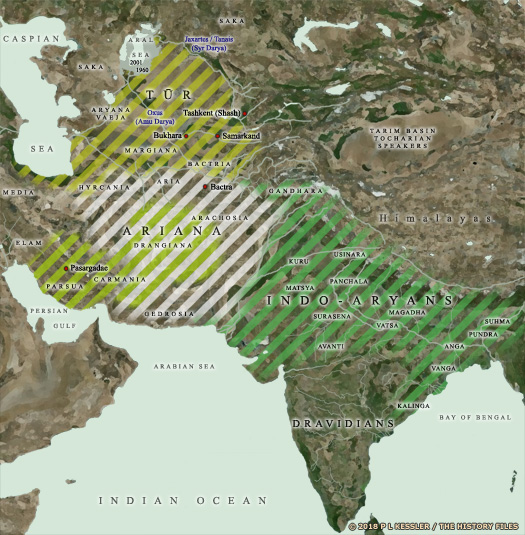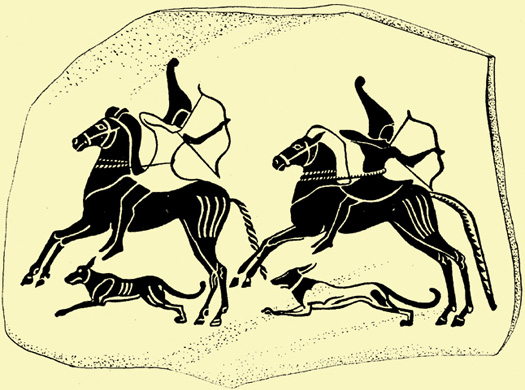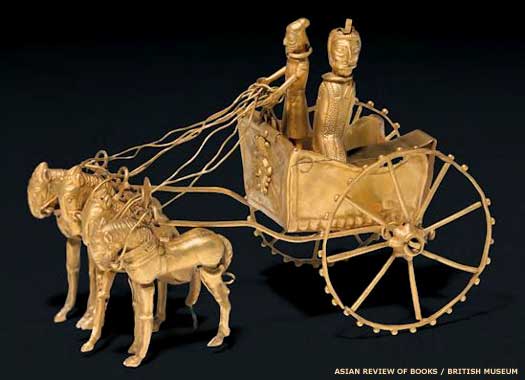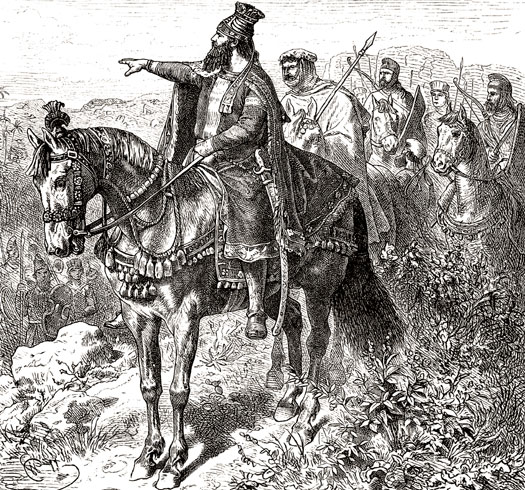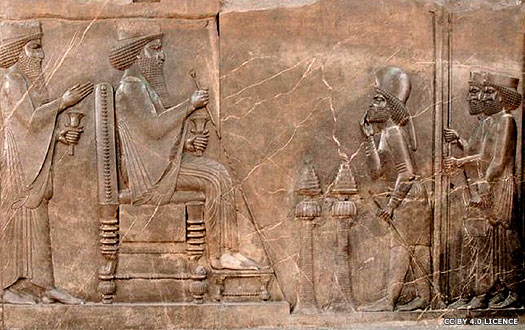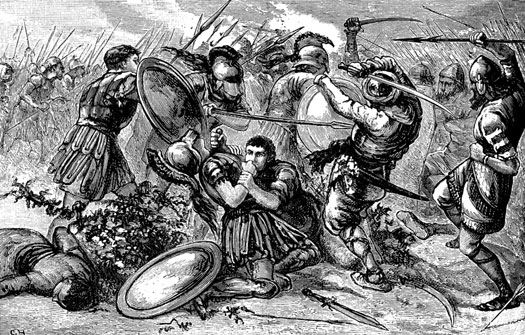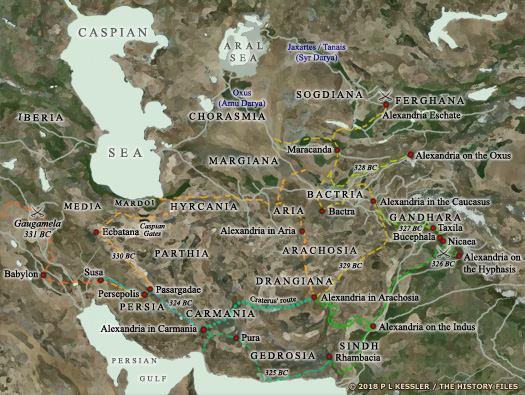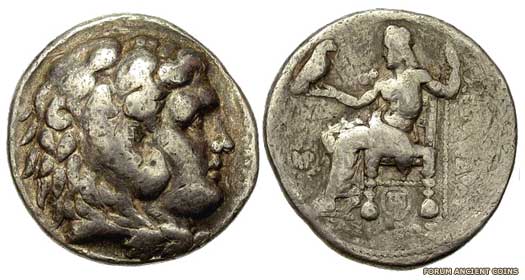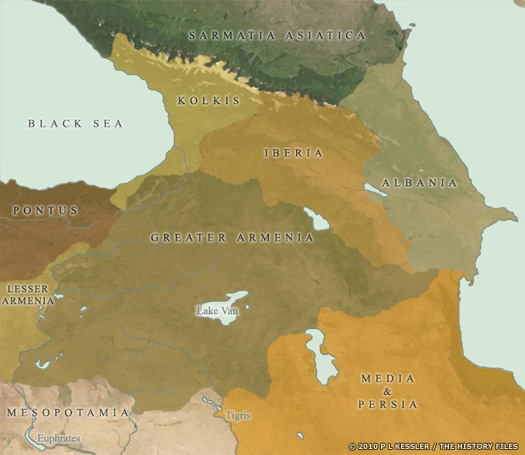
| MEDIA / AMADAI Incorporating the Arioi :
The Medes, or Medians, were a collection of Indo-Iranian tribes which entered the area of the northern Zagros Mountains from the start of the first millennium BC, during the period of instability and migration throughout the Near East which seemingly began with the destruction of the Hittite empire. The region had previously been inhabited by the Gutians, who provided third millennium Sumer with so many problems. Initially the Medians, along with other new arrivals such as the Alani, Mannaeans, and the Persians, formed a state which was a very loose coalition of tribes, each with a leader or king of its own. Consolidation came later, but all of these new arrivals contributed towards a more uncertain political sphere to the east of Babylonia and Assyria (who knew them as the Amadai).
The Medes co-operated with the Babylonians to destroy Assyria. They shared the captured territory between themselves, with Media assuming power in eastern Assyria, and north and east of the Tigris from 609 BC. By now the kingdom's capital was at Ecbatana (modern Hamadan). Unfortunately, archaeology has so far failed to turn up any finds that are older than 248 BC at Ecbatana, and the specific site itself may not even have been the location for the Median fortress of that name. Median culture at the time had an aversion to large-scale building projects and even to living in cities. Apparently, Ecbatana was home only to the king, his family, and his administration. This aversion seems to have extended to making any kind of statues or friezes. The result is that there is a sad lack of any representations of the royal family, Median life, or their army before the time of Darius II, when the Persians began showing Median troops mixed with Persians.
Originally nomadic, the Medes spoke an Iranian language which was of the Indo-Iranian branch of Indo-European. None of these new tribal arrivals in the Zagros region had any native written tradition, so their history must be pieced together from outside sources. The popular Greek forms of names of Median kings are shown below in green, and many of the details regarding the later Median empire are Greek (largely from Herodotus). In the eyes of some scholars they are not to be trusted, and Herodotus' theory of a great Median empire is total fiction designed to complete a gap in his view of a sequence of eastern empires. Some documentation does exist thanks to other Greek authors which could point to the extent of Median domination towards the east. Perhaps not an empire in the strict sense, the Medes were part of a chain of Indo-Iranian tribes or confederations of tribes which stretched back towards the Oxus. It is highly possible that at this time they were simply the most dominant of those groups. Amongst regions claimed as being part of their 'empire' was Drangiana, whilst Bactria would also seem to have been linked to it, negating the existence of a fabled 'Chorasmian empire' that is imagined by some students of Zoroastrianism.
The Medes seem to have had only one god, the fire god, whom they worshiped alongside the Persians, from the mountain tops. They did not build temples and tended to look with scorn on those who did. Around the time of Cyrus II the Persians seem to have adopted a different system, subscribing to the teachings of one of their mystics, and they eventually became Zoroastrians, who were polytheists.
As far as breaking down the name is concerned, the Assyrian 'Amadai' may be closer to the original Indo-Iranian than the Greek 'Mede'. The best match would seem to be the Avestan root 'maid-', meaning 'middle, half', which originates with proto-Indo-European 'medh'. The use of 'half' could mean half a tribe, a part of the tribe which migrated away, but more interesting is 'middle'. The Medes could have named themselves based on their settling in between the Mannaeans who were to their north and the Parsua who largely settled to their south. Assuming a name during the settlement process would mean that they weren't the Medes before they settled. However, since the Medes were made up of numerous sub-tribes (at least twenty-two in the late eighth century BC), that would probably make them a confederation rather than a single tribal group, and a confederation which only formed its group identity once it reached the Zagros Mountains. Herodotus mentions that the Medes were formerly known as Arioi (Aryans), which also supports a renaming once they had finished their westwards migration.
(Additional information by Jo Amdahl and Edward Dawson, from Empire of Gold: Foundations, Jo Amdahl, from The Persian Empire, J M Cook (1983), from The Histories, Herodotus (Penguin, 1996), from The Civilisation of the East, Fritz Hommel (Translated by J H Loewe, Elibron Classic Series, 2005), from The Routledge Handbook of the Peoples and Places of Ancient Western Asia, Trevor Bryce, from Atlas of the Bible Lands, C S Hammond & Co (1959), from The Lion Encyclopaedia of the Bible, Pat Alexander (Ed), from The Interpreter's Bible: Volume 6, Lamentations, Ezekiel, Daniel, Twelve Prophets, George Arthur Buttrick (Commentary Editor, 1956), from The Cambridge Ancient History, Volume III, The Assyrian Empire, J B Bury (Ed, Cambridge at the University Press, 1925), from A Life Application Bible Study, Dr James C Daniel (Ed, 1989), from an extensive list of further titles which are listed in the Sources section of the site, and from External Links: The Cities of the Medes (full text), Mordechai Cogan & Israel Eph'al (Eds, The Hebrew University, Jerusalem), and Old Iranian - Online Avestan Master Glossary (University of Texas at Austin), and Dictionary of most common Avesta words.)
c.1000 - 900 BC :
The Parsua begin to enter Iran, probably by crossing the Iranian plateau to the north of the great central deserts (through Hyrcania) but also by working round to the south of them. Already separated during their journey, Parsua groups head in two main directions. In time the northern groups find themselves in the Zagros Mountains alongside their cousins, the Mannaeans and Medians, who have also followed the northern route. Medians and Parsua are attested in the Zagros during the ninth and eighth centuries but the Parsua disappear afterwards.
The Zagros Mountain range provided the Medes with their home, but it was also the Assyrian gateway into Iran, one that was used in later attacks on the Indo-European Persians and Medes fl 880s BC :
Arbaces : King of (a tribe of) Medes?
First in Ctesias' unreliable list of nine kings, Arbaces is said to destroy the Assyrian city of Ninevah at this time. The Assyrians are becoming a dominant force in their region, so this attack may be an attempt to subjugate then and halt their expansion. If it works at all (and if it really happens at all), the Median success is brief. Perhaps it can be better viewed as an opportunistic raid by the newly-arriving Medians as a test of local strength.
836/835 BC : The Medes are mentioned for the first time in historical records when Shalmaneser III of Assyria receives tribute from the 'Amadai' after fighting wars against the tribes of the Zagros Mountains. Living in the central Zagros along the Khorasan road, the Medes are usually mentioned in conjunction with the Scythians, another steppe group which appears to be the dominant force in the region. They also occupy territory which stretches back into the east, seemingly along the Great Khorasan Road which follows the southern edge of the Elburz Mountains on the south coast of the Caspian Sea.
Also active at this time are the early Persians or, perhaps more accurately, the Parsua. The Assyrian king, Shalmaneser III, records their existence in 843 BC on the Black Obelisk, which covers his campaign of about that year. Their position is not precisely fixed but 'Pasua' seems to lay in what is now Iranian Kurdistan (immediately east of Kurdistan in northern Iraq), far to the north of Persis and the heart of Persian settlement and seemingly in the midst of Median settlement. These groups in the Zagros seem to drop out of the historical record, perhaps pushed south by the greater numbers of the Medes or absorbed by them.
Varbaaxshatta : Modakku
Sosarmas
Artaxshatra
fl c. 750 BC :
Xshatrita I
744 BC :
The Medes to the west of the Gizilbunda Mountains (part of the Zagros range) have enjoyed a respite in the past few years. Now a new Assyrian advance begins when the king invades Parsuai and turns it into an Assyrian province (also known as Nikur, after its capital). This refers to Parsua, but not those of southern Iran. This is one of the northern groups which had settled in the Zagros Mountains. Nikur may not be too far to the west of the later city of Ecbatana.
Possibly in the same year the Assyrians make a raid farther to the east, reaching Arazias, and a Median fortress called Zakruti. Tiglath-Pileser demands that in the whole country of the mighty Medes as far as Mount Bikni (possibly Mount Demavend close to modern Tehran), the 'lords of townships' should pay him regular tribute of nine metric tons of lapis lazuli and fifteen tons of bronze artefacts, an impossible order to fulfil.
Following the climate-change-induced collapse of indigenous civilisations and cultures in Iran and Central Asia between about 2200-1700 BC, Indo-Iranian groups gradually migrated southwards to form two regions - Tūr (yellow) and Ariana (white), with westward migrants forming the early Parsua kingdom (lime green), and Indo-Aryans entering India (green) 740s - 700 BC :
In the late eighth century, for the first time, fortified cities begin to appear in strategic locations in the Zagros, built by Assyria which soon reduces the region to three provinces in an attempt to control the trade route along the Khorasan road. Assyria's political control is incomplete, and various small groups of Medians remain independent. Some twenty-two Median chiefs pay tribute to Sargon II after 722 BC, but by this time the Medes are also starting to absorb the non-Iranian peoples in the upper valleys of the Zagros Mountains. By 735 BC the fortress of Zakruti seems to be in the process of becoming a capital of sorts, and the Medes are forming themselves into a confederation, if not a kingdom.
c.728 - 675 BC :
Dayaukku / Daiukku / Dioka / Deioces : Governor of Mannae.
Herodotus names Deioces (or Dioces), grandfather of Cyaxares, as the king who eventually unites the formerly nomadic Median tribes, forming a single kingship which is centred on Ecbatana. The six Median tribes he dominates are named as follows: the Arizanti, Budii, Busae, Paretaceni, and Struchates, plus the independent, priestly tribe of the Magi (Maggai) which serves them all. This word, 'magi', has a cognate or root in Avestan, as well as forms in Persian, Greek, and Latin. The Latin plural of 'magus' (also 'magus' in Old Persian) is 'mag'. The root is 'mag-' plus a suffix. Prior to full blown 'civilisation', priests are tacitly understood to be magicians. So the 'priestly tribe' is actually a tribe of magicians or shamen - the eastern version of Europe's distantly-related druids and close cousins of Vedic priests.
This count of six tribes does not explain the twenty-two Median chiefs who pay tribute to Sargon II, although an explanation is most likely that some or all of those could be lesser chiefs in control of subject or minor tribes. The 'six tribes' are probably tribal groups. By now, if not before, Median and Persian dress is the same, with the latter being the lesser of the two peoples.
Deioces then builds the earliest stages of the city of Ecbatana and begins a tradition in which the kings are expected to separate themselves from their own people in order to perpetuate a kind of myth-like aura around themselves, convincing their own subjects that they are not mere men. They are unapproachable by all but members of their own royal family. Anyone who has business with the king is obliged to deal with his family as intermediaries. There is literally no mention of Ecbatana having a population (other than the palace with the king and his family) until the Persians occupy the area. Accordingly the Nabonaidus Chronicle identifies the entire area, not just the fortress, as Ecbatana, so it is possible that the true city of the Medes does not form the earliest stages of the Persian Ecbatana and is yet to be discovered. Perhaps an older belief that Mount Bikni is the site of the Median fortress is correct after all.
679 BC :
Assyria king, Esarhaddon, conducts a campaign against the Cimmerians, defeating them and their leader, Teuspa, but still failing to pacify the region. In the same year Esarhaddon's troops also fight a war in Hilakku (Khilakku), and a few years later they punish the Anatolian prince of Kundu (Cyinda) and Sissu (Sisium, modern Sis), who has allied himself with Phoenician rebels against Assyrian rule. The regions to the north of the Cilician plain repeatedly cause trouble for Assyria.
However, trouble is also brewing in the Zagros Mountains. The non-Iranian peoples of the upper valleys of the Zagros are disappearing under progressive absorption by the dominant Medes. Small kingdoms such as Ellipi and Harhar are disappearing from the historical record. Even the names of petty rulers who retain independence show a progressive process of medisation.
675 - 653 BC :
Xshatrita II / Phraortes / Kashtaritu : Son. Killed by Assyria.
653 BC :
Phraortes (or Phraorla) leads the league that endangers Assyrian control of the Zagros Mountains and is himself killed in battle against Assyria. He is succeeded by his young son, but the Medians are quickly subjugated by a Scythian invasion from the steppe. One of their number rules the Medes and associated Iranian tribes, and it takes the Medians under Cyaxares almost thirty years to restore their independence.
The year 652 BC marked the apogee of Cimmerian power, with their conquest of the kingdom of Lydia, but their supremacy would last only another eleven or so years before defeat and total eclipse 653 - 625 BC :
Madyas the Scythian / Madys / Madius : Scythian overlord during the subjugation of the Medes.
625 BC :
Herodotus says that Cyaxares reigns for forty years including the time of the domination of the Scythians, but virtually all historians agree that what is meant is forty years excluding the time of the domination of the Scythians. At the beginning of his reign, Cyaxares is considered a vassal of the Scythians until he throws off their yoke in 625 BC and takes sovereign control of his country. In total then, he reigns for sixty-eight years and therefore must be very young when he succeeds his father as he continues to conduct military campaigns in person up until the year of his death.
Fritz Hommel identifies Huwaxshatra (Cyaxares) with Sandakhshatra of the Cimmerians, and his son, Ishtumegu (Astyages) with Ishtivegu. Both of these names are given in their Greek form by Herodotus but it is unclear, despite some similarity, whether they can be the same individuals. Hommel also connects the earlier Cimmerian king, Tugdamme, as Phraortes, although this seems less likely.
625 - 585 BC :
Huwaxshatra / Uvakshatra / Cyaxares : Son of Phraortes. Overthrew Scythians and Assyrian empire.
fl 614 BC :
Umakishtar : Overthrew Assyrian empire. Same as Cyaxares.
c.620 BC :
The Medians (possibly) take command of the Parsua from the weakening Assyrians who themselves had only recently taken control of the region from Elam. According to Herodotus, Media governs all of the tribes of the Iranian steppe. This sudden empire may well include territory to the east which covers Hyrcania, Parthia, Drangiana, Carmania, and Bactria. The Umakishtar mentioned for 614 BC is actually the Cyaxares who rules between 625-585 BC. Cyaxares is the Greek version of the name, with Huwaxshatra and Umakishtar being the Aramaic version of the same name, and Uvakshatra being the original Median version.
Cyaxares is the first to develop an organised cavalry with divisions which can act together and in conjunction with other units. It is this innovation that gives him the advantage over the Scythians and breaks their hold over his land. The Babylonians under Nabopolassar begin integrating cavalry into their army when Cyaxares shows the king what they can achieve (a treaty exists between the two peoples, and their armies are influenced by one another). Nabopolassar's son, Nebuchadnezzar, later employs a large organised force of cavalry. In his turn, Cyaxares begins using the heavier Assyro-Babylonian-style chariots and presumably the faster, leggier horses that pull them.
The British Museum has a collection of artefacts known as the Oxus Treasure, found near the River Oxus in Persia and dating from around the time of Cyrus the Great or perhaps just after. In this collection is a highly-detailed model of a chariot. The work is definitely Persian, but the subject matter is a Median war chariot. Its waist-high platform with large, nail-studded wheels is usually pulled by four horses. Persian chariots are shorter and lighter, only needing two horses. Also, they tended to use scythes attached to the sides of the wheels rather than studding them with nails as do the Medians. The dress of the occupants is also Median, not Persian.
The Oxus Treasure contains this Persian model of a Median war chariot, although it is only pulled by two horses rather that the customary four 616 BC :
A power vacuum has existed in the region since the fall of Elam. While Assyria itself has been invaded by the Babylonians, the Medians are able to take advantage in their own right and conquer Mannae, chief city of the Mannaeans, so that it can be integrated into the Median kingdom.
615 - 609 BC :
The Medians conclude an alliance with Babylonia, with the marriage between Amyhia, daughter of Cyaxares, and Nebuchadnezzar II, son of Nabopolasser of Babylon, being agreed to seal the alliance. Together with groups such as the Scythians the new alliance overthrows and destroys Assyria. According to Herodotus, Cyaxares is now in command of large parts of the Iranian Plateau. Nebuchadnezzar II later builds the Hanging Gardens of Babylon, one of the 'Wonders of the Ancient World', in order to assuage his bride's homesickness.
Amyhia is assumed by some historians to be the granddaughter rather than daughter of Cyaxares. This is probably because her brother, Ishtumegu (Astyages), also has a daughter named Amyhia, but that princess marries Cyrus II, not Nebuchadnezzar. Amyhia is better known historically by the Greek transliteration of her name, Amytis. She is queen of Babylon, and great-aunt of Cyrus II. Depending upon the identification of Ahasuerus (a St James Bible translation of the Greek and Old Persian Xerxes and Xšayārša respectively), she may possibly be the aunt of the nebulous Darius the Mede, who claims the kingship of the Chaldeans after the fall of Babylon's last king in 539 BC.
590/585 BC :
Again, according to Herodotus, Cyaxares captures the territory which had formed the kingdom of Urartu and, at the end of a fifteen-year war, defeats the army of Lydia at the Battle of the Eclipse. The end of the war signals the start of closer ties between the two kingdoms. Alyattes II of Lydia gives his daughter in marriage to Astyages, son of Cyaxares.
585 - 550 BC :
Ishtumegu / Astyages : Son of Cyaxares.
553 - 550 BC :
Astyages should not be confused with Alyattes II of Lydia, who is his father-in-law. Herodotus tells the story of how the Medians lose control of Achaemenid Persia when the Persian chief Cyrus rebels. In 550 BC (or 549 BC) Cyrus wins a decisive victory and Astyages is captured by his own nobles and handed over. Apparently, according to ancient writers, Astyages is subsequently granted the position of satrap of Verkâna. Harpagus, a Median of the royal house and the main cause of Astyages' defeat, conquers Anatolia for the Persians in 547-546 BC and his descendants reign in Caria and Lycia thereafter.
The sources conflict when it comes to explaining the precise relationship between Cyrus and Astyages. According to some, Cyrus is his son-in-law, while others state that he is his grandson via his daughter Mandane, and the legal heir of Media. The two versions are not necessarily in conflict with each other. Cyrus is Astyages' grandson through the latter's marriage to a Persian princess. In addition, Cyrus has also married his aunt, Astyages' daughter, Amyhia (not to be confused with his sister of the same name!), in order to cement his claim to the Median throne.
Persian
Satraps of Mada (Media) :
The conquest of the Medes by their ethnic cousins the Parsua ended several generations in which the latter had been vassals. Parsua groups had been settling for some time in Persis and Anshan (the latter being an important city of the recently-destroyed kingdom of Elam). Other groups of Parsua, perhaps less numerous, had also settled in the Zagros Mountains, probably following the Medians along their more northerly migratory trail. These groups had largely disappeared by 550/549 BC, either absorbed by the Medes or pushed southwards towards the larger Parsua settlement area. But this was when the Parsua leader Cyrus rebelled against Median overlordship and won a decisive victory to seal the Median defeat.
Under the newfound Persian empire, the great satrapy of Media was clearly one of its most important satrapies, perhaps second only to Persis itself. According to the Behistun inscription of Darius the Great, it was known to the Persians as Mada (Media is a Greek mangling of the name). Its territory extended around its capital, Ecbatana, its special position as a great satrapy apparent from the fact that senior Achaemenid princes were installed as satraps there. According to Xenophon, Cyrus the Great appointed his second son, Tanyoxarces, as the first Persian satrap of Media. His was the task of administering not only Media but also Armenia and the territory of the warlike Cadusii. One of the better-attested minor satrapies in the region is Arbelitis and its chief settlement, Arbela, where Alexander took money as booty after the Battle of Gaugamela. Arbela was also the capital of the district which revolted against Darius the Great under the leadership of Ciçantaxma of Asagarta (Sagartia). Following the rebellion's suppression, Darius subsumed his deeds against Ciçantaxma within Media as a whole, suggesting that the region belonged to Media at the time. This evidently changed not very long afterwards, and no later than by the mid-fifth century BC it was transferred to Babylonia's jurisdiction.
The Utians and many other borderland tribes such as the Cadusii, Gelae (Gelonians or Alans), and Tapuri of northern Media and the shores of the Caspian were classed as Anariaci. The word can be broken down as 'an', meaning 'not', plus 'aria', meaning 'Aryan, Indo-Iranian', and the plural suffix '-ci'. They were the 'not-Indo-Iranians', although the Gelae were indeed Indo-Iranians, if not quite of the same general group as the Persians and Medians. Eventually, though, they were absorbed into the dominant Persian population.
(Information by Peter Kessler, with additional information from The Persian Empire, J M Cook (1983), from The Histories, Herodotus (Penguin, 1996), from The Horse, the Wheel, and Language: How Bronze-Age Riders from the Eurasian Steppes Shaped the Modern World, David W Anthony, from Central Asia: A Historical Overview, Edward A Allworth (Duke University Press, 1994), from The Paths of History, I M Diakonoff (Cambridge University Press, 1999), from Islamic Reference Desk, Emeri 'van' Donzel (Brill Academic Publishers, 1994), from The Routledge Handbook of the Peoples and Places of Ancient Western Asia, Trevor Bryce, from Zur historischen Topographie von Persien. II. Die Wege durch die Persische Wüste, Wilhelm Tomaschek (1885), from Farāmarz, the Sistāni Hero: Texts and Traditions of the Farāmarznāme and the Persian Epic Cycle, Marjolijn van Zutphen, from Alexander the Great: Beyond the Divide, Charles N Pope (DomainOfMan.com, 2016), from External Links: Encyclopaedia Iranica, and Iranians & Turanians in the Avesta, and The Cities of the Medes (full text), Mordechai Cogan & Israel Eph'al (Eds, The Hebrew University, Jerusalem), and in reference to a further number of original and secondary sources included in the 'Persia and Eastwards' section of the Sources page.)
549 - ? BC :
Tanyoxarces / Tanaoxares : Son of Cyrus the Great. First satrap of Media & Kadousioi.
549 - 546 BC :
Harpagus, a Median of the royal house and the main cause of the defeat of the Medes, commands Cyrus' army in Anatolia. Starting with Khilakku, captured in 549 BC, he conquers the rest of Anatolia between 547-546 BC. Taken during this campaign are Karkâ, Lycia, Lydia, Paphlagonia, Phrygia, and Katpatuka (Cappadocia), and Harpagus and his descendants reign thereafter in Caria and Lycia as satraps of the empire, normally within the satrapy of Caria. As for Tanyoxarces, he is installed as the first Persian satrap of Media, the Kadousioi, and Armina.
Cyrus the Great freed the Indo-Iranian Parsua people from Median domination to establish a nation that is recognisable to this day, and an empire that provided the basis for the vast territories that were later ruled by Alexander the Great 521 BC :
Upon the execution of the Persian usurper, Smerdis, the Cyaxarid, Fravartiš, tries to restore the Median kingdom. His name is also translated as Farvartish or Frawartish (although the 'w' would be pronounced as a 'v'), while the Greeks understand it as Phraortes. He and his forces are pinned down by Persian generals until Darius can arrive from Babylon with a larger force and then Fravartiš is defeated, captured, and executed.
Darius the Great mentions that the revolt arises in Asagarta, which is the land of the Sargatians within the satrapy of Zranka. The Sargatians are one of the ten clans of the Parsua, raising the possibility that it is some of Darius' own people who oppose him (although not his own clan, which would be the Pasargadoi).
521 BC :
Fravartiš / Farvartish / Phraortes : Descended from Cyaxares. Pretender to throne.
Embedded into the report on the rebellion of the Fravartiš in Media is confirmation that Armina belongs to the 'Great Satrapy Media', as suggested by Xenophon and documented by the Behistun inscription. The same happens in Parthawa and Verkâna whose inhabitants, as Darius reports, had also joined Fravartiš. The quashing of the insurrections from Armina to Parthawa is chronologically coordinated in Persian records and occurs between May and June 521 BC. Another major rebellion in Mergu happens towards the end of 522 or 521 BC.
499 BC :
Hydarnes is one of the seven co-conspirators, along with soon-to-be Achaemenid ruler, Darius the Great, who are responsible for removing the 'usurper' Gaumata from the throne in 522 BC. Darius treats his colleagues as family thereafter, and Hydarnes' appointment in Media is one of the empire's plum jobs.
The central relief of the North Stairs of the Apadana in Persepolis, now in the Archaeological Museum in Tehran, shows Darius I (the Great) on his royal throne (External Link: Creative Commons Licence 4.0 International) fl 499 BC :
Widarna / Hydarnes I : One of the 'seven' co-conspirators with Darius the Great.
The Old Persian form of Hydarnes' his Greek name is Widarna or Vidrna. He is known from tablets found at Persepolis to be satrap in 499 BC, but it is equally possible that he has occupied this position since 521 BC. One of his sons, Sisamnes, becomes satrap of Haraiva while another, Hydarnes II, commands the Immortals during Xerxes' invasion of Greece and a descendant, Tissaphernes, is satrap of Sparda and Karkâ in the late fifth century BC.
fl 499 BC : Widarna / Hydarnes I : One of the 'seven' co-conspirators with Darius the Great.
The Old Persian form of Hydarnes' his Greek name is Widarna or Vidrna. He is known from tablets found at Persepolis to be satrap in 499 BC, but it is equally possible that he has occupied this position since 521 BC. One of his sons, Sisamnes, becomes satrap of Haraiva while another, Hydarnes II, commands the Immortals during Xerxes' invasion of Greece and a descendant, Tissaphernes, is satrap of Sparda and Karkâ in the late fifth century BC.
411 - 409 BC :
The Cypriot city state of Salamis breaks away from Persian control under the leadership of Evagoras. He quickly unifies the entire island and rules it in its entirety. Two years later a Median rebellion against Darius II is less successful, being very short-lived.
? - 401 BC :
Artagerses : Satrap of the Kadousioi (Cadusii). Killed in battle.
401 BC :
A second Median revolt is led by Cyrus, satrap of Asia Minor. He mobilises an army which also consists of ten thousand Greek mercenaries to attack his brother the king. Defeat leads to his death in October 401 BC at the Battle of Cunaxa.
Accompanying the many Greeks on this campaign is Xenephon, a notable Greek writer from Athens. He notes that (the now-Persian) Ecbatana is much smaller than the generous estimate given by Herodotus some half a century before him. Xenephon offers a very credible three hundred metres for each of the outer sides, and even claims that it has no walls other than that around the citadel at the very top of the hill. What Herodotus had termed walls (fortifications) could simply be painted terraces, foundations for the road, spiralling up around the hill and leading up to the palace, which at this time is certainly walled and is accented in gold. If the area around the outside of the hill where the road begins its rise is counted as part of the 'city' then its size would come much closer to Herodotus' claims.
The Battle of Cunaxa saw the end of just one in a number of internal Persian revolts that often involved thousands of troops on either side, although in this case the presence of a large body of Greek mercenaries should have been an indicator of the future threat the Greeks would become 385 BC :
The Kadousioi have been in revolt for about thirty years, and Artaxerxes II decides to take to the field in person to resolve the problem. The campaign is a fiasco, but the retreat shows the Persian king in his best light, as a leader of his men, fighting for their survival and mindful of their care. Satrap Camissares of Khilakku is killed during the campaign.
350s - 336? BC :
Bisthanes : Son of Artaxerxes III Ochus. Satrap of Mada.
338 - 336 BC :
The palace eunuch, Bagoas, murders Artaxerxes III and most of his sons. Only Arses and Bisthanes survive, and it is Arses who is placed on the throne as a puppet. When he too is killed by Bagoas and Darius III replaces him, only to turn the tables on the troublesome eunuch, Bisthanes is reported as being in attendance at court, perhaps signifying that he is no longer satrap of Mada.
336? - 331 BC :
Atropates / Atrupat : Satrap of Mada. Retained by Alexander the Great.
332 - 330 BC :
Alexander the Great's campaigns against the Persians proceeds into Syria during 333-332 BC to receive the submission of Ebir-nāri. Athura, Gaza, and Egypt also capitulate (not without a struggle in Gaza's case). In 331 BC he is ready for the expected confrontation with Darius III in the heartland of Persian territory.
At the Battle of Gaugamela (thought to be in northern Iraq) it is King Darius who blinks first. He flees eastwards and the defence of each province is left to its satrap. Alexander seizes Babylon and Susa and, having gathered intelligence on Persis, he sets out with a picked force of 17,000 men for Persepolis. The heartland of the empire is soon in Alexander's hands, and Atropates is retained as the satrap of Mada.
Argead Dynasty in Media :
The Argead were the ruling family and founders of Macedonia who reached their greatest extent under Alexander the Great and his two successors before the kingdom broke up into several Hellenic sections. Following Alexander's conquest of central and eastern Persia in 331-328 BC, the Greek empire ruled the region until Alexander's death in 323 BC and the subsequent regency period which ended in 310 BC. Alexander's successors held no real power, being mere figureheads for the generals who really held control of Alexander's empire. Following that latter period and during the course of several wars, the region was left in the hands of the Seleucid empire from 312 BC.
Media had been formed by the Indo-Iranian Medes relatively early in the first millennium BC. They created their own kingdom which usually remained independent and sometimes was very powerful until a rebellion by the subject Parsua turned the tables. Then Media was reduced to the status of a subject region, or satrapy. When the Persian empire fell to the Greeks, Media fell along with it, but it continued to be of the greatest importance. It remained a vital heartland for the subsequent Seleucid empire, just as it had been for the Achaemenid empire. Monuments still survive from this period along the Silk Road (such as the reclining Heracles at Behistun, erected around 148 BC) and elsewhere.
(Information by Peter Kessler, with additional information from Jewish War & Jewish Antiquities, Flavius Josephus, and from External Links: Encyclopćdia Britannica and Appian's History of Rome: The Syrian Wars at Livius.org, and Diodorus of Sicily at the Library of World History (dead link).)
330 - 323 BC :
Alexander III the Great : King of Macedonia. Conquered Persia.
323 - 317 BC :
Philip III Arrhidaeus : Feeble-minded half-brother of Alexander the Great.
317 - 310 BC :
Alexander IV of Macedonia : Infant son of Alexander the Great and Roxana.
323 BC :
The Achaemenid satrapies have largely been retained, although Media has been divided between the smaller northern region of Media Atropatene (thereby creating the basis for the subsequent kingdom of Atropatene), and the larger southern region, which is governed by Peithon. In fact, under the Persians the northern region had been an eastern division of Armina. Once formed, the kingdom of Atropatene continues to be ruled by members of the Persian elite, with a focus which generally mirrors the territory of modern Azerbaijan.
The route of Alexander's ongoing campaigns are shown in this map, with them leading him from Europe to Egypt, into Persia, and across the vastness of eastern Iran as far as the Pamir mountain range 328 - 320? BC :
Atropates / Atrupat : Satrap of northern Media. Former Achaemenid satrap.
320 BC :
Alexander's general, Seleucus, governs Persia during the period of the Wars of the Diadochi, and it is possible that he also has some authority over Atropates and Peithon. During the Third War of the Diadochi, the Empire of Antigonus captures areas of Seleucus' rule (between 315-312 BC) and Peithon fights alongside Antigonus, but once Persia is recovered by Seleucus, it is retained by his descendants within the Seleucid empire until 141 BC.
323? - 315 BC :
Peithon : Greek satrap of Lwr Media (from Indus). Killed by Antigonus.
318 - 317 BC :
Peithon invades Parthia, kills the incumbent satrap, and appoints his brother Eudamus as its new satrap. However, his period of enforced office seems to be relatively brief. The other satraps unify to drive them both back into Media and peace is restored.
Two sides of a silver tetradrachm struck by Peithon during his time as satrap of (southern) Media, a successful officer under Alexander and a supporter of Antigonus 316 BC :
In the resultant shifts in power and control, Cappadocia and its surrounding regions (including Paphlagonia) become part of the Empire of Antigonus and Eumenes is killed. The kingdom of Cappadocia is subsumed by the empire until 301 BC. Nikanor remains its satrap until 316 BC when he is transferred by Antigonus to govern Media. He seemingly also gains Parthia from 317 BC, possibly on a temporary basis at first which would explain his nominal continuance in office in Cappadocia until the following year. However, Parthia apparently falls to Stasander the Solian in 316 BC.
315 - 312 BC :
Nikanor / Nicanor : Greek satrap for Antigonus (ex-Cappadocia). Died in battle.
312 - 311 BC :
The Third War of the Diadochi results because the Empire of Antigonus has grown too powerful in the eyes of the other generals, so Antigonus is attacked by Ptolemy (Egypt), Lysimachus (Phrygia and Thrace), Cassander (Macedonia), and Seleucus (who is hoping to regain Babylonia). The latter indeed does secure Babylon and the others conclude peace terms with Antigonus in 311 BC. Nikanor is removed from his position by Seleucus and is killed in battle attempting to retrieve it.
312 - 305? BC :
? : Greek satrap for Seleucus, name unknown.
305 BC :
The Fourth War of the Diadochi sees Media and Persis ruled by the Hellenic Seleucid empire from Babylon and then Antioch, in Syria. The satraps of Media and Persia - or Persis (the region as opposed to the former empire) - answer directly to the Seleucid ruler, although precisely how much control is wielded from Antioch is unclear. In essence the satraps in the eastern regions operate as they see fit, within certain limits.
Macedonian Media (Southern Media / Lesser Media) :
The Greek general, Seleucus, fought a number of wars as the empire fragmented in order to secure his own hold on power. In 312 BC he regained Babylon from the Empire of Antigonus and safely held it while Antigonus tried to retrieve it (until 309 BC). After that Seleucus was able to expand his holdings with some ruthlessness, building up his stock of Alexander's far eastern regions as far as the borders of India and the River Indus (Sindh). Appian's work, The Syrian Wars, provides a detailed list of these regions, which included Arabia, Arachosia, Aria, Armenia, Bactria, 'Seleucid' Cappadocia (as it was known) by 301 BC, Carmania, Cilicia (eventually), Drangiana, Gedrosia, Hyrcania, Media, Mesopotamia, Paropamisadae, Parthia, Persia, Sogdiana, and Tapouria (a small satrapy beyond Hyrcania), plus eastern areas of Phrygia.
The final of these wars was the Fourth War of the Diadochi ('successors', these being Alexander's generals), which followed the murder of Alexander IV and helped to set Seleucus' own borders. When Antigonus proclaimed himself king in 306 BC, all the other surviving generals followed suit, confirming the dismantling of the empire into various regional domains. The stage was set for the final showdown at the Battle of Ipsus, which left Antigonus and Lysimachus defeated and the Seleucid empire virtually unchallenged between Anatolia and Central Asia.
Media had been already been divided during Alexander's lifetime between the smaller northern region of Media Atropatene (thereby creating the basis for the subsequent kingdom of Atropatene), and the larger southern region - Lesser Media. In fact, under the Persians the northern region had been an eastern division of Armina. Once formed, the kingdom of Atropatene continued to be ruled by members of the Persian elite, with a focus which generally mirrored the territory of modern Azerbaijan. To the south, the chronology of the Median satraps seems to be completely unknown unless they revolted against Seleucid rule, and even then the details are often lacking in the complete story. Coinage was issued by the Seleucid emperor in Syria, and there are a few local issues to provide names, even though the interpretation of numismatic evidence can sometimes be very uncertain.
(Information by Peter Kessler, with additional information by Edward Dawson, from The Marshals of Alexander's Empire, Waldemar Heckel, from Jewish War & Jewish Antiquities, Flavius Josephus, from Revised Chronology for the Late Seleucids at Antioch, O Hoover, from Thundering Zeus: The Making of Hellenistic Bactria, Frank Lee Holt, from The Impact of Seleucid Decline on the Eastern Iranian Plateau, Jeffrey D Lerner (1999), and from External Links: University of Leicester, and Listverse, and Virtual Religion: Into His Own, and Encyclopćdia Britannica, and Appian's History of Rome: The Syrian Wars at Livius.org, and Diodorus of Sicily at the Library of World History.)
? - 220 BC :
Molon / Molo : Seleucid satrap of Media. Bro of Alexander of Persis. Killed.
223 - 221 BC :
Antiochus III sets about rebuilding the Seleucid empire which is shown to be very weak at this time. Media and Persis immediately stage a joint rebellion in 223 BC under their satraps, the brothers Molon and Alexander. Ill-advised in the matter, Antiochus sends generals east to deal with them while he embarks on a farcical attack on Egypt to regain lost territory in the south. Both campaigns end in utter defeat. In the north, Achaeus, Antiochus' cousin, records the only immediate success by forcing Pergamum back to its original borders.
Ecbatana was the capital of Media, a prized possession of the Seleucid empire and one that had to be regained upon the event of a revolt - this view shows the surviving ancient walls in modern Hamadan in Iran Antiochus deals personally with the eastern rebellion in 221 BC. It collapses in the face of his advance, with Molon's forces deserting him. Molon commits suicide to avoid capture, and a replacement to govern the satrapy is almost certainly appointed, although his name is unknown. Another rebel, Artabazanes of Atropatene, also buckles and Atropatene is captured.
220 - ? BC :
? : Unnamed replacement for Molon.
? - 175 BC :
? : Unnamed satrap.
175 - 160 BC :
Timarchus of Miletus : Seleucid satrap of Media. Revolted in 163 BC. Killed.
163 - 160 BC :
The reign of young Antiochus V of the Seleucid empire is a busy one. Recognised by Rome in favour of his uncle, Demetrius, he and his regent, Lysias, then suffer the revolt of Timarchus of Miletus, satrap of Media in 163 BC. They win a victory in the war against Judas Maccabeus at Beth-Zechariah in 162 BC, but then Antiochus' advisor, Philip, revolts in Antioch. A peace treaty is agreed with the Maccabaeans, giving them favourable terms because the Seleucid troops are needed in Antioch and Media. Antiochus is killed by his own uncle before he can use those troops.
Timarchus accepts the title of 'great king' (just as Eucratides I of Bactria had accepted this title a couple of years earlier). Babylonia is soon under his control, if not from the start of his rebellion (the extent of the realm under the control of Timarchus is contested. It is unclear whether he had been the governor of all territories east of the Euphrates or the Tigris. If the former, then he had already been responsible for Babylonia too, but if the latter then he must have taken it by force or through the threat of force). It takes until 160 BC for Demetrius to overthrow and kill him and accept the title 'soter', meaning 'saviour', from the grateful Babylonians.
160 - ? BC :
? : Unnamed satrap following Demetrius' defeat of the rebels.
c.148 BC :
The reclining Hercules of Behistun dates from around this year, at the very end of Seleucid control of Media. The demigod is shown quietly resting and drinking from a bowl, after performing one of his labours. Time and nature eventually result in it being buried by sand and soil until 1958 when the local road is lowered. At first it has no head, but this is found a couple of days later only to be stolen. Today's version is a copy.
? - 148/1 BC :
? : Last Seleucid satrap of Media. Territory lost to Parthians.
141 BC - AD 4 :
Seleucid rival claimant Antiochus VI is recognised in Antioch, and Demetrius is forced to flee to Seleucia near Babylon, although he only makes it thanks to soldiers from Judea who save his life. However, the Parthians under the very able Mithradates I make the most of the Seleucid civil war by taking Media in 141 BC (sometimes given as 148 BC).
During the first two centuries AD the kingdom of Armenia was used as a buffer state and as a battlefield by the Romans from the west and the Parthians from the east (via Media). The wars caused the division of Lesser Armenia in AD 56, as well as the further division of Armenia Sophene In the same year Mithradates also captures Seleucia and then Uruk. Although it briefly loses Media and Babylonia to Antiochus VII in 130-129 BC, thereafter the Parthian empire retains its holdings in Mesopotamia until it eventually breaks up, leaving behind it a patchwork of kingdoms which remain in a loose alliance with one another for a further two hundred years. Media is still a Parthian possession in the first century BC, when Mithradates III, the regicide son of Phraates III, is titled 'king of Media'. However, in a fight for superiority against his equally reprehensible brother he is killed.
Source :
https://www.historyfiles.co.uk/ |
